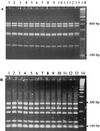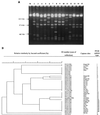Coyotes (Canis latrans) as the reservoir for a human pathogenic Bartonella sp.: molecular epidemiology of Bartonella vinsonii subsp. berkhoffii infection in coyotes from central coastal California
- PMID: 11060089
- PMCID: PMC87562
- DOI: 10.1128/JCM.38.11.4193-4200.2000
Coyotes (Canis latrans) as the reservoir for a human pathogenic Bartonella sp.: molecular epidemiology of Bartonella vinsonii subsp. berkhoffii infection in coyotes from central coastal California
Abstract
Bartonella vinsonii subsp. berkhoffii was originally isolated from a dog suffering infectious endocarditis and was recently identified as a zoonotic agent causing human endocarditis. Following the coyote bite of a child who developed clinical signs compatible with Bartonella infection in Santa Clara County, Calif., this epidemiological study was conducted. Among 109 coyotes (Canis latrans) from central coastal California, 31 animals (28%) were found to be bacteremic with B. vinsonii subsp. berkhoffii and 83 animals (76%) had B. vinsonii subsp. berkhoffii antibodies. These findings suggest these animals could be the wildlife reservoir of B. vinsonii subsp. berkhoffii. PCR-restriction fragment length polymorphism (PCR-RFLP) analysis of the gltA and 16S rRNA genes for these 31 isolates yielded similar profiles that were identical to those of B. vinsonii subsp. berkhoffii. Partial sequencing of the gltA and 16S rRNA genes, respectively, indicated 99.5 and 100% homology between the coyote isolate and B. vinsonii subsp. berkhoffii (ATCC 51672). PCR-RFLP analysis of the 16S-23S intergenic spacer region showed the existence of two different strain profiles, as has been reported in dogs. Six (19%) of 31 Bartonella bacteremic coyotes exhibited the strain profile that was identified in the type strain of a canine endocarditis case (B. vinsonii subsp. berkhoffii ATCC 51672). The other 25 bacteremic coyotes were infected with a strain that was similar to the strains isolated from healthy dogs. Based on whole bacterial genome analysis by pulsed-field gel electrophoresis (PFGE) with SmaI restriction endonuclease, there was more diversity in fingerprints for the coyote isolates, which had at least 10 major variants compared to the two variants described for domestic dog isolates from the eastern United States. By PFGE analysis, three Bartonella bacteremic coyotes were infected by a strain identical to the one isolated from three healthy dog carriers. Further studies are necessary to elucidate the mode of transmission of B. vinsonii subsp. berkhoffii, especially to identify potential vectors, and to determine how humans become infected.
Figures





Similar articles
-
Seroepidemiology of Bartonella vinsonii subsp. berkhoffii infection in California coyotes, 1994-1998.Emerg Infect Dis. 1999 Sep-Oct;5(5):711-5. doi: 10.3201/eid0505.990514. Emerg Infect Dis. 1999. PMID: 10511529 Free PMC article.
-
Spatial analysis of Yersinia pestis and Bartonella vinsonii subsp. berkhoffii seroprevalence in California coyotes (Canis latrans).Prev Vet Med. 2003 Jan 15;56(4):299-311. doi: 10.1016/s0167-5877(02)00194-0. Prev Vet Med. 2003. PMID: 12507856
-
A Bartonella vinsonii berkhoffii typing scheme based upon 16S-23S ITS and Pap31 sequences from dog, coyote, gray fox, and human isolates.Mol Cell Probes. 2006 Apr;20(2):128-34. doi: 10.1016/j.mcp.2005.11.002. Epub 2006 Feb 7. Mol Cell Probes. 2006. PMID: 16460911
-
Bartonella spp. in pets and effect on human health.Emerg Infect Dis. 2006 Mar;12(3):389-94. doi: 10.3201/eid1203.050931. Emerg Infect Dis. 2006. PMID: 16704774 Free PMC article. Review.
-
Factors associated with the rapid emergence of zoonotic Bartonella infections.Vet Res. 2005 May-Jun;36(3):383-410. doi: 10.1051/vetres:2005009. Vet Res. 2005. PMID: 15845231 Review.
Cited by
-
First Pediatric Case of Tularemia after a Coyote Bite.Case Rep Infect Dis. 2016;2016:8095138. doi: 10.1155/2016/8095138. Epub 2016 Jan 13. Case Rep Infect Dis. 2016. PMID: 26885419 Free PMC article.
-
Vector-borne and zoonotic diseases of dogs in North-west New South Wales and the Northern Territory, Australia.BMC Vet Res. 2017 Aug 15;13(1):238. doi: 10.1186/s12917-017-1169-2. BMC Vet Res. 2017. PMID: 28810870 Free PMC article.
-
Molecular epidemiology of Mycoplasma conjunctivae in Caprinae: transmission across species in natural outbreaks.Appl Environ Microbiol. 2003 Apr;69(4):1913-9. doi: 10.1128/AEM.69.4.1913-1919.2003. Appl Environ Microbiol. 2003. PMID: 12676664 Free PMC article.
-
Molecular evidence of Bartonella spp. in questing adult Ixodes pacificus ticks in California.J Clin Microbiol. 2001 Apr;39(4):1221-6. doi: 10.1128/JCM.39.4.1221-1226.2001. J Clin Microbiol. 2001. PMID: 11283031 Free PMC article.
-
Bartonella and Toxoplasma infections in stray cats from Iraq.Am J Trop Med Hyg. 2013 Dec;89(6):1219-24. doi: 10.4269/ajtmh.13-0353. Epub 2013 Sep 23. Am J Trop Med Hyg. 2013. PMID: 24062480 Free PMC article.
References
-
- Abbott R C, Chomel B B, Kasten R W, FloydHawkins K A, Kikuchi Y, Koehler J E, Pedersen N C. Experimental and natural infection with Bartonella henselae in domestic cats. Comp Immunol Microbiol Infect Dis. 1997;20:41–51. - PubMed
-
- Baker J A. A rickettsial infection in Canadian voles. J Exp Med. 1946;84:37–50. - PubMed
-
- Baneth G, Kordick D L, Hegarty B C, Breitschwerdt E B. Comparative seroreactivity to Bartonella henselae and Bartonella quintana among cats from Israel and North Carolina. Vet Microbiol. 1996;50:95–103. - PubMed
MeSH terms
Substances
LinkOut - more resources
Full Text Sources
Molecular Biology Databases

